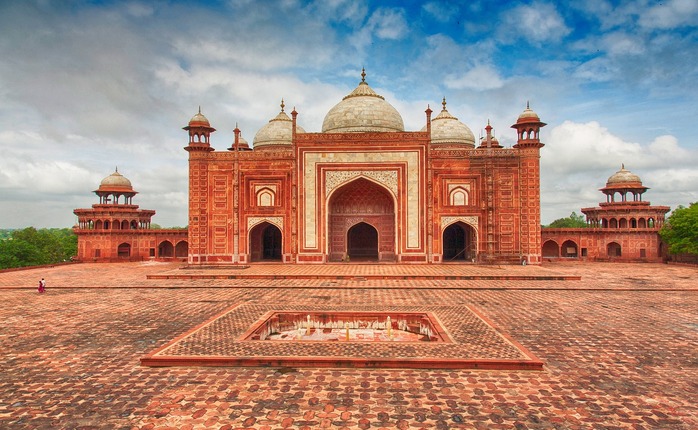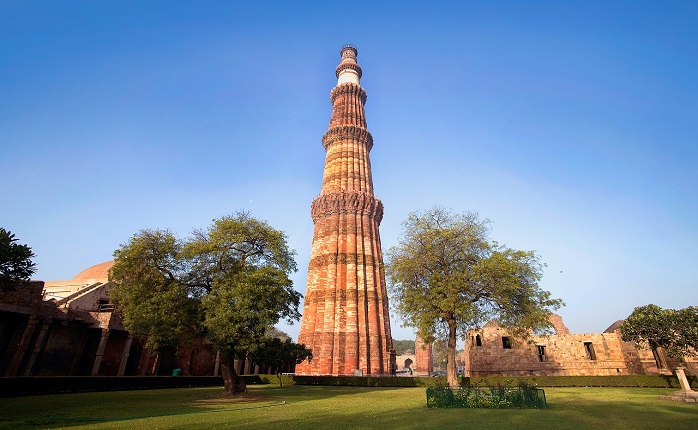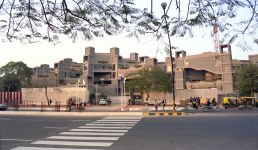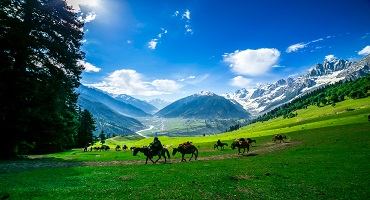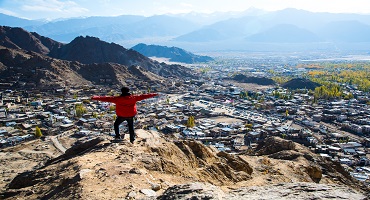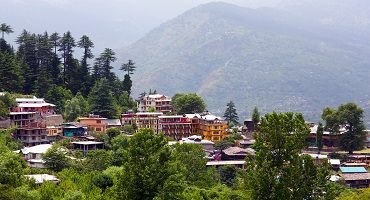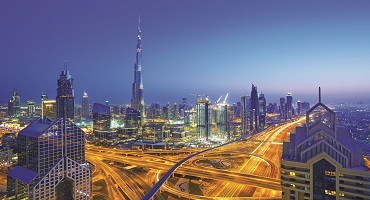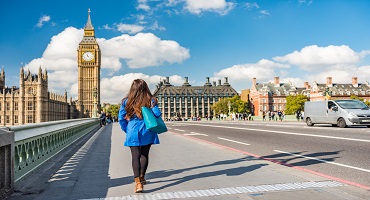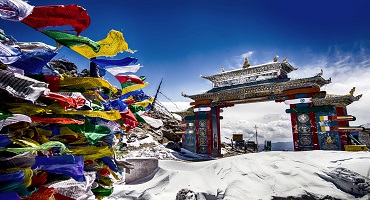Located in one of the poshest localities of Delhi, the Safdarjung Tomb is a stunning Mughal-era structure that has become one of the most famous tourist attractions in Delhi. Constructed in 1754 by Nawab Shujaud Daula, the monument lies next to the Safdarjung Airport and is visited by hundreds of tourists each day.
The tomb is beautiful and built in a style that resonates with the earlier Mughal architecture, similar to what can be witnessed in monuments such as the iconic Taj Mahal. It is historically significant because it signified the waning of the Mughal empire.
The Safdarjung Tomb is situated in South Delhi and is well-connected by public transport. If you are planning a trip to see this gorgeous monument, you will have a lot to do and explore in the area, as the Safdarjung Tomb location is bustling with energy and activity. Take a look at this article to know more.
History of Safdarjung Tomb
The Safdarjung Tomb, built by Nawab Shujaud Daula in 1754, is the very last garden tomb of the Mughal era. Ever since the tomb of Humayun was constructed in the garden style, many other Mughals did the same for their loved ones. But with the construction of the tomb of Safdarjung, this trend came to an end.
Safdurjung, whose real name was Mirza Muqim Abul Mansur Khan, was a statesman of the Mughal rulers. He was born in Persia but moved to India in 1722 to become the Subadar Nawab of Oudh or the ruler of the Awadhi Empire. He held this position for as long as he was alive and at the time, was one of the most powerful and influential rulers in the country. After his death, his son Nawab Shujaud Daula commissioned the construction of the Tomb. It took close to a decade to be built and was one of the most expensive and intricate architectural projects taken on by the royal court.
According to the Safdarjung Tomb history, the monument was designed by an Ethiopian architect and the design was largely inspired by the design of Humayun's Tomb. However, even though this project was large and elaborate, the finished tomb could never match up to the finesse and creativity of Humayun’s tomb.
Interesting facts about Safdarjung Tomb
If the Safdarjung Tomb history has left you fascinated, you will be even more mesmerised after learning about the various interesting facts related to this monument. Here are some of the best ones that have been handpicked for you:
Part of the structure belonged to another tomb
This is one of the most interesting facts about Safdarjung Tomb. Some of the rock slabs made to construct the Safdarjung Tomb were originally used in the tomb of Abdul Rahim Khankhana.
It is made of sandstone
The Tomb is made out of pure sandstone. It has a distinct brown colour. The inner chambers are beautiful and there are many carvings on the wall. Though it does not match up to the grandeur of the Tomb of Humayun, it still is very pretty in its own right.
Surrounded by gardens
Safdarjung’s Tomb is surrounded by a majestic garden. It has some of the prettiest flowers and plants, all of which are carefully cared for by designated gardeners. It was very characteristic of the architecture of the time and you will find the same design in a lot of tombs built in the Mughal era.
Dyes used
In the 1820s, the Bishop of Calcutta, Reginald Heber, did extensive research on the Tomb. His finding confirmed that a unique brown die was used to render colour to the inner chamber walls of the Tomb of Safdarjung. This was a significant discovery because using any form of wall paint, including dyes, was quite uncommon in those times.
Last Mughal historical building
As mentioned above, there were many tombs created for the Mughal emperors and their family members. At one point in time, it had almost become a trend to do so. Architects from around the world were hired to design and construct these elaborate monuments. The Tomb of Safdarjung was the last monument to be built in this trend as after that, no Mughal memorial has been made into a garden tomb.
Protected monument
Safdarjung Tomb is one of the buildings in the city that are protected by the Government. It finds itself in the list of protected buildings and hence is well taken care of.
After learning about these very interesting facts about Safdarjung Tomb, you would surely want to visit the place, wouldn't you? Then wear the planner’s hat and plan your trip right away, today itself!
Best time/ Season to visit Safdarjung Tomb
The Safdarjung Tomb location is in the heart of Delhi. The weather of Delhi, therefore, plays an important role in ensuring how comfortable your stay will be when you travel to the city to see the Tomb. The best time to visit Delhi and to determine the ideal vacation time is to understand the weather patterns and then plan. Here are some handy pointers for you:
Summer:
Are you aware that the maximum temperatures in Delhi can go up to around 50 degrees Celsius in the months of May and June? Yes, you heard that right! The summers are extremely uncomfortable in Delhi and they are so hot that heat waves are often reported too. People prefer staying indoors at such times and so it may not be the best time to go to Delhi for a vacation. However, since schools are on vacation at this time, lots of tourists do come in. You too can plan a trip but ensure you are well-prepared.
Monsoon:
The monsoons last from July to September and often bring forth heavy rainfall. This hampers travel and sightseeing plans so it would not be recommended for you to travel to Delhi and visit Safdarjung Tomb at this time. However, this is an off-season and the hotels are available at great prices. So if you are planning a trip, you may just find a great deal and get a good opportunity to see the tomb on a rare day of sunshine.
Winter:
The winters in Delhi, though quite chilly, are very famed! The winters see a large number of tourists pouring into the city from not just India, but other parts of the world as well. It is very pleasant and sunny during the day and that gives you the perfect setting to visit famous monuments like the Safdarjung Fort and Tomb. You can spend hours exploring these beautiful monuments without feeling hot and sweaty. You can also do a lot of walking and not get tired. The evenings and nights get very cold, so it is best to stay indoors at night and keep the sightseeing activities for the daytime.
Keeping the points mentioned above in mind, it can safely be said that wintertime is the best time to visit the city of Delhi and explore the Tomb of Safdarjung. However, this does not mean that travel is prohibited at other times of the year. You can visit at any time or you can even take a day trip to the Tomb if you happen to be in the city for some other work at any time of the year. Just ensure you dress properly and stay hydrated so that you can enjoy the trip without any hiccups.
Location of Safdarjung Tomb
The exact location of the monument is Air Force Golf Course, Delhi Race Club, New Delhi. It is situated in the southern part of the city and is quite accessible by public and private transport. The place is situated right between the iconic Lodhi Road and Aurobindo Marg.
How to Reach Safdarjung Tomb?
Many people who travel to Delhi to see the famous Safdarjung ka maqbara, travel by train. Delhi has one of the best rail connectivity in the world. You can find a train from any city or town in India to reach Delhi. Delhi has a number of railway stations and hundreds of trains come in each day. If you too are planning to visit the Safdarjung Tomb, you can reach Delhi by train. It is easy to find a route, but for the tickets, you will need an advance booking. Once that is done, you can find a train in a quick manner. Train travel is relatively inexpensive as well.
Your next option to reach Delhi is to travel by air. Air travel is easy in India, though it is more expensive than train travel. You can find flights from all major Indian destinations that come into Delhi. You can take a direct flight or you can take a hopping flight, depending on your preferences and availability. Book the plane tickets in advance to get the best deals.
Your final option is to reach by road. You can either opt to drive your own vehicle from a nearby Indian city or hire a cab and do a road trip. Road travel is convenient and the most economical option. It is highly flexible too. If you are on a tight budget, you can also take a public bus. Air Conditioned and non-air-conditioned buses are widely available to and from Delhi, so finding a route is never difficult. You can also make on-the-spot reservations, which makes it all the more convenient for you, especially if you make a last-minute plan to visit the Tomb of Safdarjung.
Once you arrive in Delhi, you won't have too many issues reaching the monument. Since it is such a famous tourist spot, all the local auto rickshaws and cab drivers know the place. You can just hop on to any taxi or auto and quickly reach the destination. You can also tire a tourist taxi from your travel agent or check with your hotel’s travel desk for offers. If you have your own vehicle, then driving down to the Tomb becomes all the more simple.
Instructions for Visiting Safdarjung Tomb
Some monuments in Delhi such as the Qutub Minar have been closed for entry to the inner chambers. However, the case is not the same with the Tomb of Safdarjung and you can easily go inside Safdarjung Tomb. It is a beautiful and fascinating place that has eight rooms and a main chamber. However, since it is a holy, resting place, there are some protocols that you need to respect and follow when you visit. From refraining from shouting or laughing, to keeping the premises clean, you should play your part to ensure such amazing moments never lose their glory. Here are some important guidelines related to the Safdarjung Tomb entry fee details and timings for your knowledge:
Operational days:
Safdarjung ka maqbara is open on all days, including bank holidays and weekends. You can visit it from dawn to dusk and enjoy the calm and serene atmosphere. You can plan to see the monument at peace by devoting an entire day to it or you can squeeze in a short visit when exploring all the famous attractions of Delhi.
Ticket price:
If you are a citizen of India, you have to pay an entry fee when you look to enter the Tomb of Safdarjung. The Safdarjung Tomb ticket is priced at Rs 15 for Indians and Rs 200 for people of foreign nationalities. The ticket you purchase is valid for the whole day and there is no time restriction associated with it. You can enter the beautiful tomb area, explore the chambers and lounge out in the garden for as long as you like. If you wish to take a camera with you, you have to pay an additional fee of Rs 25. The photos you click, however, must only be for personal use.
Opening & Closing Time:
The Safdarjung Tomb timings are from seven in the morning to six in the evening. You can visit at any time between these hours. But if you ask any local person, they will tell you to get in early in the morning. This is because the weather is cool and the sun is not too harsh in the morning hours. The weather gets hotter and brighter as the day progresses.
Do your research and visit the Tomb while you are well-prepared. This will save you time and energy and will also make it easier for you to experience the history and culture of the place.
Language spoken in Safdarjung Tomb place
Hindi being the local language around the Safdarjung Tomb location, is the most widely spoken language there. Everyone you see there speaks in Hindi, so if you are conversant in Hindi, you should not have too many problems in communication. Many tour guides available there also speak English and some also speak other languages such as Spanish and Russian. However, to ensure you get a guide who speaks your language, you will have to book ahead. Some of the local cab drivers and shopkeepers also speak some amount of English, so getting by may not be very difficult for tourists in and around the Safdarjung’s Tomb.
Things to do in the Safdarjung Tomb location
As mentioned above, the Safdarjung Tomb is located in a very upscale neighbourhood in Delhi. It is a posh residential area that has markets, restaurants, and other attractions to explore. Here are some of the interesting things to do in Delhi that you can indulge in while exploring the area around the tomb:
Shopping:
Khan Market, one of Delhi’s oldest and most popular markets, is very close to the Tomb of Safdarjung. Once you are done visiting the tomb, head over to Khan Market and shop till you drop! From large and fancy stores selling branded clothes to smaller stalls selling local handicrafts, you will find everything you need in this bustling market. Some of the oldest bookstores in the city are also found in this market and you can pick up some very interesting books from these places. Bargaining does happen, so make sure you bargain for a lower price when you shop.
Eating:
Khan Market has some of the best eateries in all of Delhi. From modern cafes and bakeries to old-school restaurants dishing out traditional delicacies, you will find a wide range of food items in this location. Apart from Khan Market, there are many other food places to explore around the Tomb of Safdar Jang. You can find many roadside stalls selling the famous street foods of Delhi such as chaat, lassi, kulfi, and kachori. Golgappas, pizzas, rolls, etc are all available so no matter what your preferences are, make sure you fuel up and savour the local delicacies of Delhi when you visit the tomb.
Exploring the area:
Delhi is a bustling metropolis that has a fascinating mixture of old-world charm and modern life. When you go to the city to see Safdarjung Tomb, make sure you soak up all the flavours of Delhi. Walk down the streets, shop at the local markets, eat the local food, speak to the people around you, use public transport, and click as many photographs as you can. Just taking a leisurely stroll and absorbing the ambience will be one of the most enriching experiences for sure.
Now that you know more about the interesting things to do around Safdarjung’s Tomb, go ahead and give them a try and you will come back with memories of a lifetime.
Popular places to visit around Safdarjung Tomb
As stated, Delhi is a city that has a very rich culture and history. There are many historical monuments present in this city and there are also many stunning gardens and pathways. If you want to explore some of the best tourist attractions around Safdarjung Tomb, here are some of the must-visit places for you:
Qutub Minar:
If you visit Delhi, you should aim to see the famous monuments. It may not be possible for you to see all the monuments in one day but try to see the landmark places such as the very iconic Qutub Minar. One of the oldest and highest minarets in the country, the Qutub Minar is a beautiful spectacle. Located about seven kilometres away from The tomb Of Safdarjung, the Qutub Minar complex has the Minar along with several other attractions that you can enjoy.
Lodhi Garden:
Next on the list, we have Lodhi Garden. It is a beautiful green, open space that has a peaceful and serene atmosphere. You can spend hours and hours in this place. And if you are lucky, you can catch some very interesting dance dramas and other beautiful art performances.
Akshardham Temple:
Located about seven kilometres away lies the magnificent and stunning Swaminarayan Akshardham temple. It is a temple with many modern features such as digital shows, extraordinary lighting, and IMAX presentations. Visit this temple and get to see some of the most spectacular visuals.
Gurudwara Bangla Sahib:
Just four kilometres away from the Tomb lies the world-famous Bangla Sahib Gurudwara. It is a massive and very popular gurdwara that is flooded with thousands of devotees every day. The highlights of the place are the golden dome of the gurdwara and the large water reservoir inside it.
Delhi Haat:
A very famous and varied shopping complex in the heart of Delhi, the place is just about two kilometres away from Safdarjung Tomb. You can find many interesting items to shop for. Don't miss a chance to visit the Delhi Haat when you visit Safdarjung’s Tomb.
Rashtrapati Bhavan:
Last but certainly not least, you must check out the Rashtrapati Bhavan, which is the official residence of the President of India. It is a gigantic palace and one of the largest residential palaces in the world.
It helps a lot when you plan ahead. So get organised and make a suitable itinerary before you leave for your trip to Delhi. If seeing and learning more about Safdarjung Tomb is your priority, keep a couple of days for that. Make all your bookings and reservations so that when you reach the city, all you have to do is go to the beautiful attractions and explore them.

